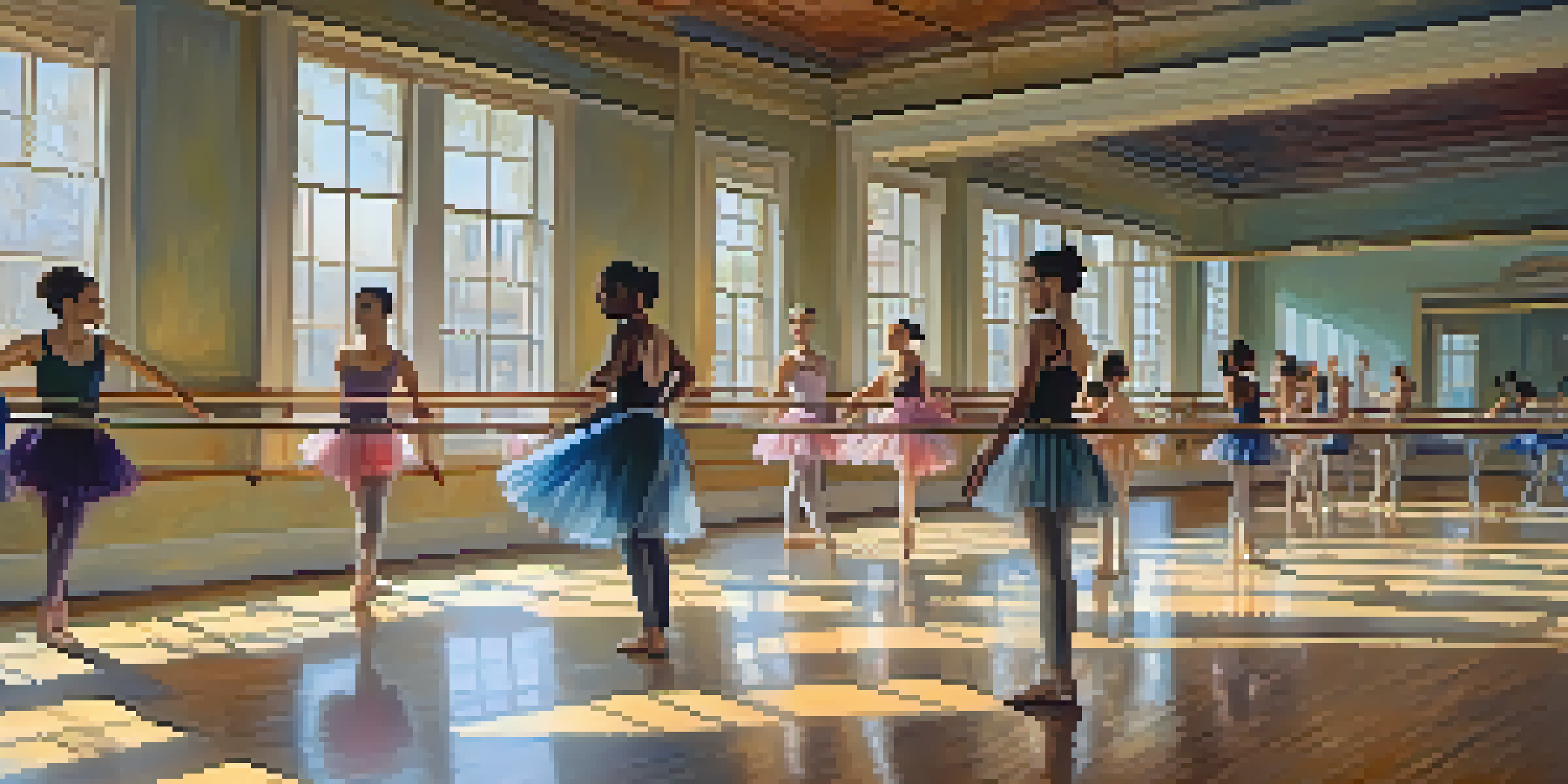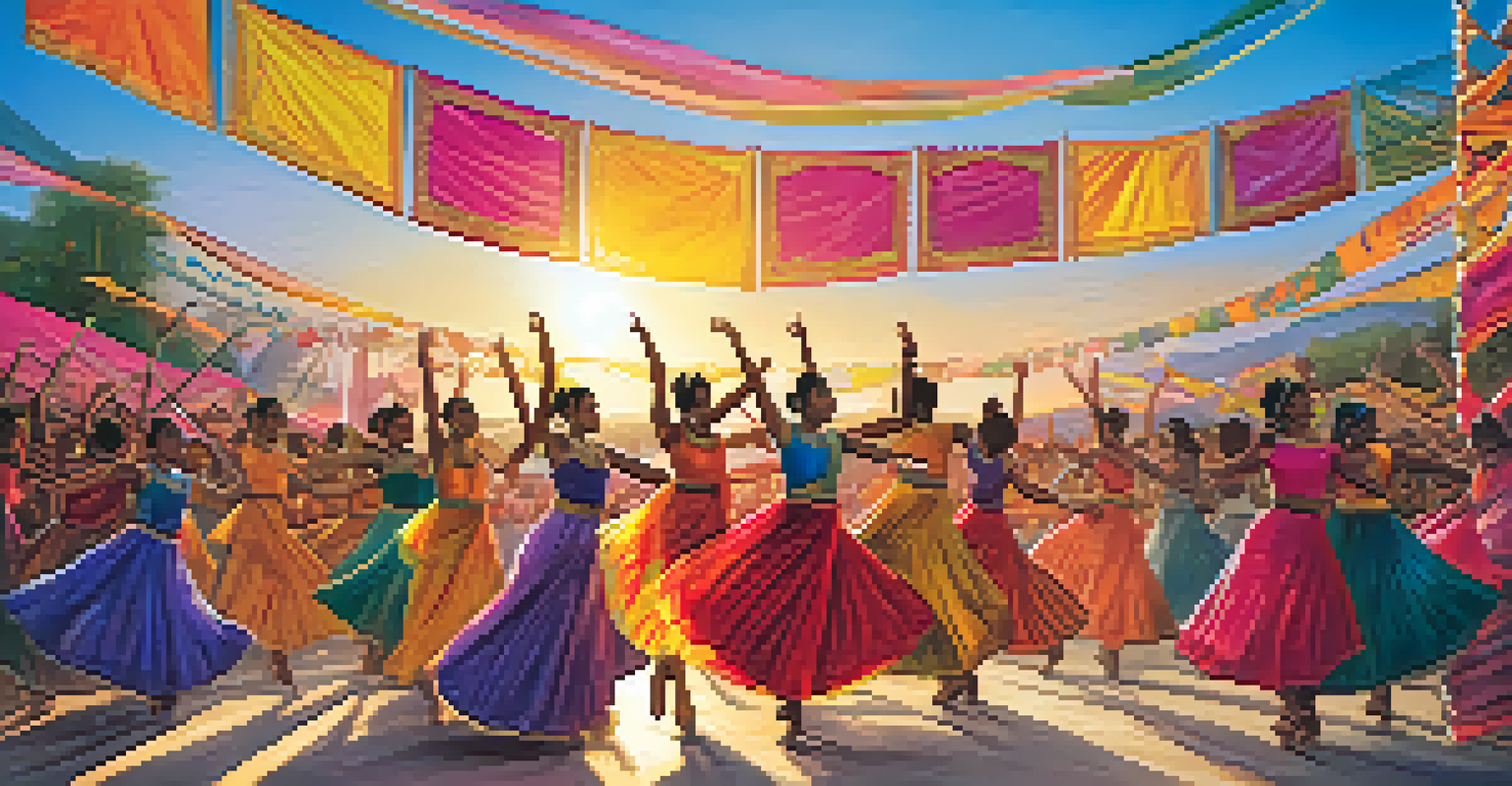Globalization's Role in the Evolution of Ballet Techniques

Understanding Globalization and Ballet's Roots
Globalization refers to the interconnectedness of cultures, economies, and people across the globe. In the context of ballet, it signifies the way ballet has transcended geographical boundaries, influencing and being influenced by various cultures. This cross-pollination has not only enriched the art form but also led to the evolution of ballet techniques that integrate diverse movements and styles.
Ballet is a story told with music and dance, a universal language that transcends culture and speaks to the heart.
Ballet, originating from the Italian Renaissance courts, has always been a blend of various influences. As it spread to France and Russia, it absorbed local traditions, which laid the groundwork for its further evolution. Similarly, globalization has opened doors for contemporary forms of ballet to emerge, reflecting a tapestry of global influences that redefine traditional techniques.
Today, we can see how different cultures contribute to the ballet landscape. For example, the incorporation of African dance movements or Asian philosophies into ballet showcases how global interaction fosters innovation. This blend not only diversifies the performances but also makes ballet more accessible and relatable to audiences worldwide.
Cultural Exchange: A Catalyst for Innovation
Cultural exchange plays a vital role in shaping the evolution of ballet techniques. As dancers and choreographers travel and collaborate across borders, they bring their unique backgrounds and experiences into the studio. This exchange fosters creativity, leading to the development of new styles and movements that challenge traditional norms.

For instance, the fusion of hip-hop and ballet has gained popularity, creating a dynamic and fresh approach to storytelling through dance. This innovative blend not only attracts younger audiences but also encourages dancers to experiment with their bodies in ways that traditional ballet may not allow. Such collaborations highlight the adaptability of ballet in a rapidly changing world.
Globalization Enriches Ballet
Ballet has evolved through cross-cultural influences, integrating diverse movements and styles that enhance its accessibility and relevance.
Moreover, cultural festivals and competitions have become platforms for showcasing this diversity. Events like the International Ballet Competition allow dancers from various backgrounds to share their interpretations of ballet. This not only elevates the art form but also inspires future generations to merge their cultural identities with ballet.
The Impact of Technology on Ballet Techniques
Technology has revolutionized how ballet is taught, performed, and shared. Online platforms now provide access to dance tutorials and master classes from renowned dancers around the world. This democratization of knowledge means that aspiring dancers can learn diverse techniques without being limited by their geographical location.
Dance is the hidden language of the soul.
Additionally, social media has become a powerful tool for dancers to showcase their work and connect with a global audience. Viral dance challenges have sparked interest in ballet, encouraging a younger generation to explore this classical art form. The visibility of ballet in the digital realm fosters a sense of community, where dancers from different cultures can inspire each other.
However, while technology broadens access, it also raises questions about the preservation of traditional techniques. As ballet evolves, balancing innovation with respect for classical training becomes crucial. Striking this balance ensures that while ballet adapts, it does not lose its rich heritage.
Globalization's Influence on Ballet Education
Ballet education has witnessed significant changes due to globalization. Institutions now emphasize a more holistic approach, integrating various dance styles into their curricula. This shift prepares students to be versatile performers, equipping them with a broader skill set that includes not only classical ballet but also contemporary and world dance forms.
Furthermore, international workshops and exchanges allow students to learn directly from masters of different styles. This exposure not only enhances technical skills but also fosters cultural appreciation among young dancers. It cultivates an environment where students are encouraged to explore their creativity and embrace diverse influences.
Cultural Exchange Sparks Innovation
Collaboration among dancers from different backgrounds fosters creativity, leading to new styles like the fusion of hip-hop and ballet.
Despite these advancements, traditional ballet training remains essential. The challenge lies in preserving the foundational techniques while encouraging innovation. By blending classical training with global influences, ballet education can continue to evolve, nurturing well-rounded artists who honor their roots.
The Role of Global Festivals and Competitions
Global festivals and competitions serve as melting pots for diverse ballet styles, reflecting the impact of globalization on this art form. Events such as the Youth America Grand Prix and the Prix de Lausanne attract participants from all over the world, showcasing their unique interpretations of ballet. These gatherings not only elevate the level of performance but also inspire cultural exchanges among dancers.
During these competitions, dancers are often exposed to various styles and techniques that broaden their artistic horizons. The diversity of performances encourages participants to step out of their comfort zones and experiment with new movements. This spirit of exploration is essential for the growth of ballet as it continues to evolve in response to global influences.
Moreover, these festivals provide opportunities for networking and collaboration, often leading to international partnerships. Dancers who meet at these events may later work together, blending their unique backgrounds to create innovative works. This interconnectedness propels the ballet community forward, ensuring its relevance in a globalized world.
Emerging Styles: Blending Tradition with Modernity
As ballet interacts with various cultural influences, new styles are emerging that blend traditional techniques with modern expressions. Contemporary ballet, for example, often incorporates elements of jazz, hip-hop, and even street dance, resulting in a more dynamic and accessible form of ballet. This fusion not only attracts new audiences but also challenges the perceptions of what ballet can be.
Choreographers are increasingly experimenting with narrative storytelling through movement, drawing from personal and cultural experiences. This approach allows for a deeper emotional connection with audiences, as it reflects the complexities of contemporary life. By embracing innovation while respecting the classical roots, these new styles keep ballet alive and relevant.
Technology Transforms Ballet Education
Online platforms and social media democratize ballet learning, allowing aspiring dancers to explore various techniques from anywhere in the world.
Additionally, the emphasis on individuality and personal expression in dance mirrors broader societal trends toward inclusivity and diversity. As ballet continues to evolve, it opens its doors to a wider range of voices and stories, enriching the art form and ensuring its future sustainability.
Conclusion: Ballet's Future in a Globalized World
The evolution of ballet techniques through globalization is a testament to the art form's resilience and adaptability. As ballet embraces diverse influences, it becomes a richer, more inclusive art that resonates with audiences worldwide. This ongoing transformation encourages dancers to explore their cultural identities while preserving the essence of classical ballet.
Looking ahead, the future of ballet lies in its ability to harmonize tradition with innovation. By fostering an environment that values both classical techniques and contemporary expressions, the ballet community can continue to thrive. This balance will ensure that ballet remains not only a celebration of artistry but also a reflection of our interconnected world.

Ultimately, globalization has opened up a world of possibilities for ballet, allowing it to evolve while staying true to its roots. As we witness this exciting journey, we can embrace the beauty that comes from blending cultures and techniques, creating a vibrant and dynamic future for ballet.